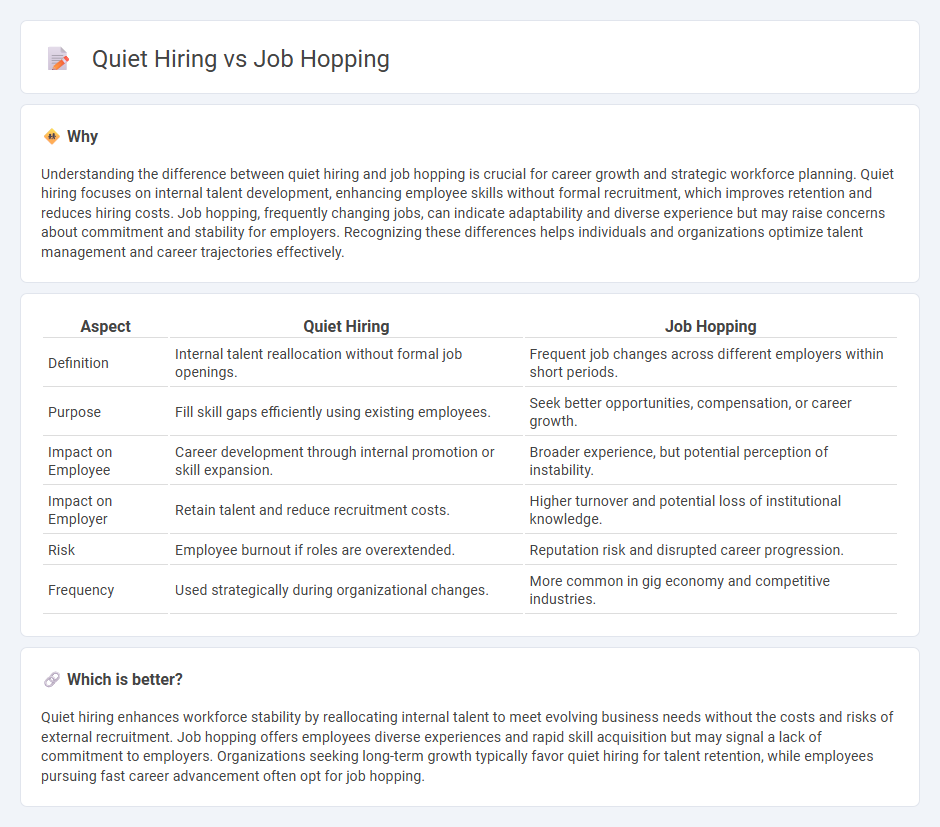
Quiet hiring focuses on internal talent development by reallocating existing employees to new roles, enhancing workforce stability and reducing recruitment costs. Job hopping, characterized by frequent switches between employers, often leads to broadened skill sets but may impact long-term career progression. Explore how these contrasting employment trends shape modern workforce strategies and individual career paths.
Why it is important
Understanding the difference between quiet hiring and job hopping is crucial for career growth and strategic workforce planning. Quiet hiring focuses on internal talent development, enhancing employee skills without formal recruitment, which improves retention and reduces hiring costs. Job hopping, frequently changing jobs, can indicate adaptability and diverse experience but may raise concerns about commitment and stability for employers. Recognizing these differences helps individuals and organizations optimize talent management and career trajectories effectively.
Comparison Table
| Aspect | Quiet Hiring | Job Hopping |
|---|---|---|
| Definition | Internal talent reallocation without formal job openings. | Frequent job changes across different employers within short periods. |
| Purpose | Fill skill gaps efficiently using existing employees. | Seek better opportunities, compensation, or career growth. |
| Impact on Employee | Career development through internal promotion or skill expansion. | Broader experience, but potential perception of instability. |
| Impact on Employer | Retain talent and reduce recruitment costs. | Higher turnover and potential loss of institutional knowledge. |
| Risk | Employee burnout if roles are overextended. | Reputation risk and disrupted career progression. |
| Frequency | Used strategically during organizational changes. | More common in gig economy and competitive industries. |
Which is better?
Quiet hiring enhances workforce stability by reallocating internal talent to meet evolving business needs without the costs and risks of external recruitment. Job hopping offers employees diverse experiences and rapid skill acquisition but may signal a lack of commitment to employers. Organizations seeking long-term growth typically favor quiet hiring for talent retention, while employees pursuing fast career advancement often opt for job hopping.
Connection
Quiet hiring strategically addresses talent gaps by internally reallocating existing employees or recruiting for unadvertised roles, reducing reliance on external job markets and mitigating turnover. Job hopping, characterized by frequent employee transitions, challengesTalent acquisition stability and prompts organizations to adopt quiet hiring as a retention and skill optimization tactic. Integrating quiet hiring thus serves as a proactive response to the dynamic patterns of job hopping in evolving labor markets.
Key Terms
Retention
Job hopping often indicates employee dissatisfaction and can lead to increased recruitment costs and organizational instability. Quiet hiring emphasizes internal talent development and strategic skill allocation, enhancing employee retention and engagement. Discover how integrating quiet hiring practices can transform your retention strategy.
Talent Acquisition
Job hopping involves frequent transitions between employers, which can offer fresh skills and diverse experiences but may raise concerns about employee loyalty in talent acquisition. Quiet hiring focuses on internal talent development and redeployment, enhancing workforce agility without external recruitment costs. Explore how these strategies impact recruitment efficiency and organizational growth in talent acquisition.
Workforce Flexibility
Job hopping reflects an employee's pursuit of diverse experiences and rapid career growth, while quiet hiring enables organizations to enhance workforce flexibility by internally reallocating talent without public recruitment. Both strategies address shifting market demands and skill shortages, but job hopping emphasizes individual agility as quiet hiring prioritizes internal mobility and resource optimization. Explore the benefits and challenges of job hopping and quiet hiring to better understand their impact on workforce flexibility.
Source and External Links
What Is Job Hopping? (Plus Advantages and Disadvantages) - Indeed - Job hopping is the practice of frequently changing jobs within a short period, once frowned upon but now increasingly common as workers seek better pay, roles, or face unavoidable changes like layoffs; employers still want to see valid reasons and dependability despite this trend.
Job-Hopping With Intention: Pros, Cons, and Considerations - FlexJobs - Job hopping typically involves staying one to two years per job and is motivated by seeking better career paths, cultural fits, challenges, or new skills; although once viewed negatively, it is now recognized as a strategic choice by many to grow and remain engaged professionally.
Job Hopping | What is it and what are its advantages? - Iberdrola - Job hopping refers to frequent voluntary changes of employment, especially among young digital professionals driven by ambition and a desire for continual challenges, and is increasingly valued by companies recognizing the dynamic talent it represents.
 dowidth.com
dowidth.com